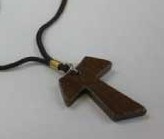
Where did the Tau come from and what does it mean? Simply and basically, the Tau (rhymes with “how”) represents the cross. It is also the last letter of the Hebrew Alphabet. However, the two major influences on Francis concerning the TAU were the Antonians and the Fourth Lateran Council.
St. Francis borrowed the Tau and what it meant to him from the Antonians. They were a religious community of men founded in 1095 whose sole function was to care for lepers. The Church disbanded them as an Order in the 1500s because leprosy was no longer a problem and many of the religious orders had fallen into theological problems. On their habit was painted a great Tau cross. Francis was very familiar with these men because they staffed the leper house in Assisi and the hospital of St. Blase in Rome where Francis went to stay. This is now the church of San Francisco A Ripa. Every time you see St. Anthony, “the Abbot or Hermit” in art, he is portrayed with the Tau. St. Francis was exposed to the Tau through the direct influence of the Antonians, but the greatest influence of all that made the Tau so dear to Francis, whereby it became his signature, was the Fourth Lateran Council.
Pope Innocent III opened the Council on November 11, 1215, with these words: “I have desired with great desire to eat this Passover with you.” (Luke 22-15.) Innocent announced that for him, for the Church, and for every Catholic at the time, the symbol they were to take as the sign of their Passover was the Tau Cross.
He incorporated into his homily the statement from Ezekiel (9:4) that the elect, the chosen, will be marked with the sign of the Tau. He explained that this Passover is a three-fold Passover. Every Catholic must be involved in this triple Passover: A Corporal Passover, a Spiritual Passover and an Eternal Passover. These became some of the most precious themes of Francis’ preaching. He took them so deeply to heart that when Pope Innocent III ended his homily with “Be champions of the Tau”, Francis evidently took that as a personal statement and made the Tau his own symbol: a symbol for his order, as well as his signature, and had great devotion to it for the rest of his life.
(Used with permission from Tau-USA Newsletter; a publication of the U. S. National Fraternity of the SFO)
